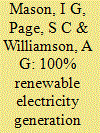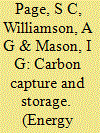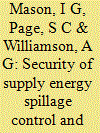|
|
|
Sort Order |
|
|
|
Items / Page
|
|
|
|
|
|
|
| Srl | Item |
| 1 |
ID:
097208


|
|
|
|
|
| Publication |
2010.
|
| Summary/Abstract |
The New Zealand electricity generation system is dominated by hydro generation at approximately 60% of installed capacity between 2005 and 2007, augmented with approximately 32% fossil-fuelled generation, plus minor contributions from geothermal, wind and biomass resources. In order to explore the potential for a 100% renewable electricity generation system with substantially increased levels of wind penetration, fossil-fuelled electricity production was removed from an historic 3-year data set, and replaced by modelled electricity production from wind, geothermal and additional peaking options. Generation mixes comprising 53-60% hydro, 22-25% wind, 12-14% geothermal, 1% biomass and 0-12% additional peaking generation were found to be feasible on an energy and power basis, whilst maintaining net hydro storage. Wind capacity credits ranged from 47% to 105% depending upon the incorporation of demand management, and the manner of operation of the hydro system. Wind spillage was minimised, however, a degree of residual spillage was considered to be an inevitable part of incorporating non-dispatchable generation into a stand-alone grid system. Load shifting was shown to have considerable advantages over installation of new peaking plant. Application of the approach applied in this research to countries with different energy resource mixes is discussed, and options for further research are outlined.
|
|
|
|
|
|
|
|
|
|
|
|
|
|
|
|
| 2 |
ID:
090034


|
|
|
|
|
| Publication |
2009.
|
| Summary/Abstract |
Carbon capture and storage (CCS) is considered a leading technology for reducing CO2 emissions from fossil-fuelled electricity generation plants and could permit the continued use of coal and gas whilst meeting greenhouse gas targets. However considerable energy is required for the capture, compression, transport and storage steps involved. In this paper, energy penalty information in the literature is reviewed, and thermodynamically ideal and "real world" energy penalty values are calculated. For a sub-critical pulverized coal (PC) plant, the energy penalty values for 100% capture are 48.6% and 43.5% for liquefied CO2, and for CO2 compressed to 11 MPa, respectively. When assumptions for supercritical plants were incorporated, results were in broad agreement with published values arising from process modelling. However, we show that energy use in existing capture operations is considerably greater than indicated by most projections. Full CCS demonstration plants are now required to verify modelled energy penalty values. However, it appears unlikely that CCS will deliver significant CO2 reductions in a timely fashion. In addition, many uncertainties remain over the permanence of CO2 storage, either in geological formations, or beneath the ocean. We conclude that further investment in CCS should be seriously questioned by policy makers.
|
|
|
|
|
|
|
|
|
|
|
|
|
|
|
|
| 3 |
ID:
124290


|
|
|
|
|
| Publication |
2013.
|
| Summary/Abstract |
In this paper, issues of security of supply, energy spillage control, and peaking options, within a fully renewable electricity system, are addressed. We show that a generation mix comprising 49% hydro, 23% wind, 13% geothermal, 14% pumped hydro energy storage peaking plant, and 1% biomass-fuelled generation on an installed capacity basis, was capable of ensuring security of supply over an historic 6-year period, which included the driest hydrological year on record in New Zealand since 1931. Hydro spillage was minimised, or eliminated, by curtailing a proportion of geothermal generation. Wind spillage was substantially reduced by utilising surplus generation for peaking purposes, resulting in up to 99.8% utilisation of wind energy. Peaking requirements were satisfied using 1550 MW of pumped hydro energy storage generation, with a capacity factor of 0.76% and an upper reservoir storage equivalent to 8% of existing hydro storage capacity. It is proposed that alternative peaking options, including biomass-fuelled gas turbines and demand-side measures, should be considered. As a transitional policy, the use of fossil-gas-fuelled gas turbines for peaking would result in a 99.8% renewable system on an energy basis. Further research into whether a market-based system is capable of delivering such a renewable electricity system is suggested.
|
|
|
|
|
|
|
|
|
|
|
|
|
|
|
|
|
|
|
|
|